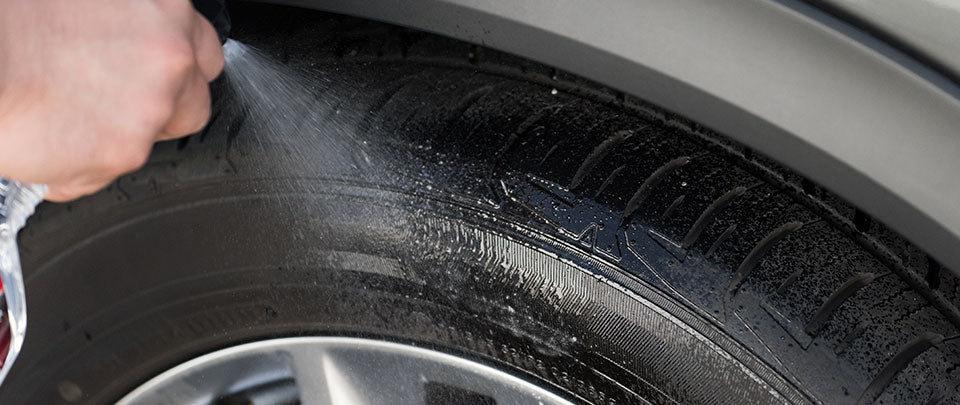No Products in the Cart
Cleaning and preening is what the Mothers® Detail Guide is all about. From the simplest tasks to the most technically challenging, our Guide covers it all.
Posted on May 7, 2021

Being at ground level, tires get coated in the usual suspects; including road grime, dirt and brake dust. Also, a portion of the chemicals used to make tires will break down during the their lifespan – it’s a natural process, fueled by chemistry and exposure – and it causes a grey/brown chalky film to appear on a tire’s surface. A regime of regular washing will keep you ahead of the bulk of it, including whitewalls and raised-white lettering (use a firm nylon brush to give the sidewalls a scrub once you’ve washed the rest of the car). However, there are plenty of cases where car soap and elbow grease can’t break through the film (or perhaps you just want to avoid breaking a sweat). In these cases, tire cleaners like Mothers® Foaming Wheel & Tire Cleaner and Back-to-Black® Tire Cleaner, are formulated to effortlessly clean off dirt, funk, and even old tire dressings.

If you use a spray on, hose off tire cleaner like Mothers® Foaming Wheel & Tire Cleaner, it’s best to do so before you wash the car (and as instructed). Tire and wheel-care chemicals can be powerful – mind the time (and watch the clock) when using them. Make sure you only use them on original equipment manufactured (OEM) wheels – they are not made for aftermarket surfaces like anodized, polished aluminum and billet. Note: after your initial rinse, you should rerinse your tires, and wash them like usual. This will keep tire-cleaning gunk from splashing on your freshly washed car. There’s a step-by-step video describing the use of Mothers®’ new Foaming Tire & Wheel Cleaner online – check it out.

Not all situations allow for hose and spray. Multifamily residences (aka apartments and condos), water restrictions and more can dampen (uh, so to speak) your tire care regiment. Waterless cleaners like Mothers® Tire Cleaner will easily remove stubborn browning, dirt, soil, grease, grime, road film, brake dust and old dressings, without getting the hose out. Just spray directly on the sidewall, let sit for a few seconds, then wipe clean. If you use Back-to-Black® Tire Cleaner, a handy how-to can be seen here on the Mothers® YouTube Channel.
As with most car-care products, be sure to follow the instructions on tire cleaners. Certain cleaners are spray-on, while others are applied with a cotton rag or sponge like applicator. Back-to-Black® Tire Cleaner, for instance, likes to be sprayed directly on the tire. Some, like Foaming Wheel & Tire Cleaner, use stronger cleaning agents and don’t play well with some types of wheel finishes, while Back-to-Black® Tire Cleaner is safe for virtually any surface and can be wiped off without worry.

Always use tire and wheel products expressly intended for motorcycles when cleaning them. Because of the special relationship motorcycles have with gravity (and the handling dynamics of two-wheeled vehicles), any tire-care product that leaves a slippery coating can compromise safety. Also, motorcycles have ultralight metal parts that don’t like certain cleaners.

The process of cleaning tires should include some consideration of their long-term health. Regular treatments with a tire dressing such as Speed Tire Shine and Back-to-Black® Satin Tire Shine can help protect tires from environmental abuse, your abuse, sunborne UV exposure (and subsequent cracking), fading, browning, and premature failure (premature anything is never welcome). The regular use of tire protectants also result in a desirable glossy black tire that sticks around longer than your next drive. Apply dressing after the tires have been cleaned and everything is dry.
If you’re working with tires on a vehicle that’s garaged and not driven frequently, regular cleaning with Back-to-Black® Tire Cleaner should be enough. It will remove browning, leaving the surface clean and matte black.
For a regularly used car or truck that sees more time on the road, the black-tire effect and general glossiness of Back-to-Black® Tire Shine and Speed® Satin Tire Shine will last longer – it’s an honest show-car tire shine for your daily driver.

Tire dressings can usually be spritzed (that’s a technical term) directly on the tire, but in Mothers®’ experience, it’s more efficient to spray the product onto an applicator or cloth, and then rub the sponge onto the tire with a light buffing action.

How you apply and remove any tire treatment will affect the final appearance: Mothers® tire shines can either be left on for high-gloss, or rubbed out for a smooth, even glow.

Unless you’re working with rodded ’32 Ford or any like-minded madness, a wheel well and fender liner surrounds most tires. The proper appearance of that well and liner contributes to the overall look of a clean car or truck (especially on a high-profile rig that shows a lot of liner). The same beat-up wash-mitt you use for sidewalls and the undercarriage is just fine for sudsing up the wheel wells. The roadworn black plastic in there will look better after a scrub, and you can apply Mothers® Back-to-Black® Trim and Plastic Restorer with a cotton towel or microfiber cloth to clean and blacken the blackness. Or, you can use Back-to-Black® Trim and Plastic Restorer - Aerosol for a quick splash of protection.
You will likely encounter some grease and other mechanical chemicals in the wells (as well), which is why you’re using a wash-mitt or sponge that doesn’t touch your paint. Use (and keep for next time) a dedicated applicator for spots like wheel wells and the undercarriage, ones that might not be as seemly as more exposed surfaces. Avoid cleaning grease from parts that are supposed to be greasy (squeaky clean > squeaky).